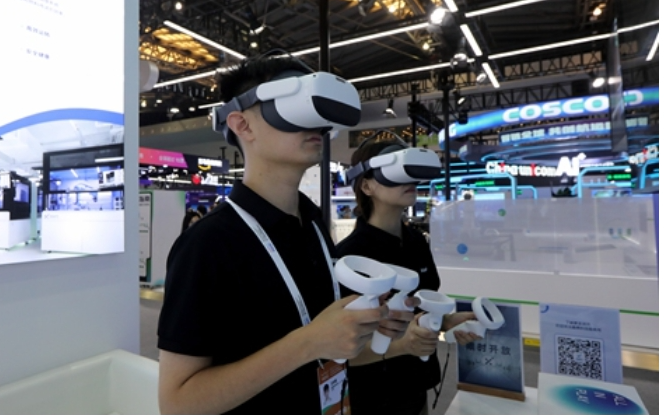Amid the eager anticipation of visitors, a young woman’s photo appears on a large screen. Next to the photo is a video of a woman with almost the same look who breaks into a radiant smile. “She” runs her fingers through her hair and waves enthusiastically to the people standing around. “She” crackles the atmosphere with excitement.
“She” is Vimi, a controllable AI (artificial intelligence) character that debuted at the World AI Conference (WAIC) in Shanghai on Thursday as one of the conference’s highlight exhibits this year.
Six years have passed since the first WAIC took place in the municipality. The event has now become a globally influential conference in the AI field as well as a platform that has effectively promoted the establishment of Shanghai as a scientific and technological innovation center. This year, it reached unprecedented levels in terms of exhibition scale, number of exhibitors, featured exhibits, and debut products.
Covering an exhibition area of 52,000 square meters, the event focused on key fields such as large language models, computing power, robotics, and autonomous driving. It showcases the latest achievements in “AI+” applications and unveils numerous highly anticipated innovative products.
Over 500 companies participated in the event, with more than 50 percent coming from outside Shanghai or overseas.
The much-anticipated WAIC 2024 was a stage for the booming Chinese AI industry, with more than 50 new products, large language models, or related systems of Chinese AI enterprises debuting at the conference.
They, along with many other innovative and technical exhibits, jointly showcased how China’s fast-developing AI technology is bringing convenience, efficiency, and a better quality of life to not only Chinese people but people all over the world.
Vimi, for instance, is allegedly the world’s first AI controllable character video generation product that can generate a video of a person with just one photo. Developed by Chinese AI software giant SenseTime, this product can drive character images using motion videos or animations by artists to produce videos that match the target movements, introduced Liao Hu, who leads Vimi’s product operations.
“Among similar human character video generation products, we can say that it is the best in the world,” Liao told the Global Times on Thursday.
“Vimi can control both facial expressions and body movements and is able to generate realistic movements in hair, clothing, background, and lighting,” he added.
At the crowded venue, QuantumPharm Inc (XtalPi), a Chinese AI and robotics platform company, drew visitors’ attention with an AI automated workstation placed at the center of its exhibition area. Through the glass windows of the lab, a robotic arm could be seen skillfully dispensing solutions and powders into test tubes.
A staffer at XtalPi explained that the lab was carrying out various stages of chemical reactions to synthesize and test molecules as directed by the AI model.
“This approach is a departure from traditional chemical reaction tests,” he told the Global Times.
“The AI model not only designs the molecules, but also enables the automation of many procedures that traditionally require manual labor, such as synthesis and analysis.”
XtalPi self-developed the lab’s core systems, including operating and scheduling systems, said the staffer. He added that the labs have been put into use on a large scale within the company and similar products have been delivered to its first batch of clients.
“We are at the forefront of AI automated chemistry labs operating on a grand scale,” he told the Global Times. The AI automated labs, which are good at carrying out basic tests and recording experimental data, can save R&D personnel time and provide important information for future iterations of AI models, he said.
AI self-driving technology also caught the eyes of many visitors at the WAIC venue on Thursday. At the exhibition area of Chinese automotive robocar brand JiYue, visitors waited in line to try its first AI-powered electric robocar named JiYUE 01.
“Hi Simo, close the doors, move back the assistant driver seat, and angle the right front rearview mirror a little higher,” the Global Times reporter gave the voice assistant “Simo” instructions while sitting in the car. It seems that except for seat belts, almost all the devices and functions in the car could be controlled by voice.
A big screen at the front of the car showed a map that simulated road conditions. Also sitting in the car, JiYue’s product expert Hu Chenyang showed off the driver assistant system developed by Chinese companies.
“When the system is on, we can take both feet off the accelerator,” he told the Global Times. “The system operates independently.”
This year’s exhibition also featured a humanoid robot zone that showcased 25 humanoid robots. Highlights included the launch of Qinglong, the world’s first full-size open-source general humanoid robot, and China’s first full-size humanoid robot open-source community. Tesla also debuted its Optimus Gen 2, while Unitree displayed China’s first full-size general-purpose humanoid robot, the H1, which is capable of running.
As the development of AI has entered a new stage of large-scale application, the exhibition also featured a series of new terminals across various industries, such as livelihood, education, media, and entertainment.
In addition to these three main highlights, the WAIC 2024 exhibition also delved into the frontiers of digital health and smart healthcare. Visitors were also able to explore how low-carbon energy is reshaping our environment, experience the intelligent transformation of commercial retail, appreciate the convenience and innovation brought by financial technology, explore the infinite possibilities of smart cities, enjoy the technological charm of entertainment and sports, and witness how intelligent education is enlightening the next generation.
Connecting top global resources, the event injected vigorous momentum into the development of AI in Shanghai and demonstrated the city’s firm determination to seize opportunities in AI, accelerate the development of world-class industrial clusters, and build itself into a “highland” of AI, the organizer told the Global Times.

